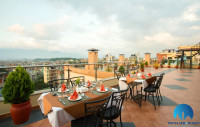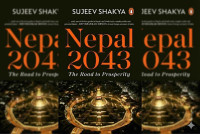Culture & Lifestyle
Nepalgunj’s oldest library is on the cusp of a slow death
Once a thriving space for students and litterateurs, Mahendra Pustakalaya is itself on the verge of becoming archived.
Madhu Shahi
The books are arranged in a neat row, as if they had not been touched for months, or maybe years. Nepalgunj’s legendary Mahendra Pustakalaya looks deserted—not a single person is inside the two-storey building.
“Nobody visits the library anymore,” says Sachchidananda Chaube, library chief. “It’s been ages since any student visited the library.”
The library based in Rani Talau was established by a group of young bookworms 73 years ago during the Rana regime, when schools weren’t open for public in the region.
“People began to flock to the library after the fall of the Rana regime. It used to be filled with students trying to get their hands on the books,” 81-year-old Chaube recalls. “This library has given birth to many noted politicians, litterateurs, and intellectuals.”
It is here that future litterateurs and politicians such as Yogeshwor Mishra, Shiva Prasad Bajpayee, Mahavir Gupta, and Basudev Sharma spent their formative years reading.
The library, which was originally named Prem Pustakalaya, was renamed in 1967 AD after King Mahendra, who at the time contributed Rs45,000 to the place and insisted the name be changed after his.
According to Chaube, before the dawn of the internet, many people visited the library, but the number of visitors trickled down to nil following easy accesibilty to digital technologies.
The rise of digital technology may have decreased the number of book readers, but there are other factors as well that led to the library’s deplorable state, including the government’s indifference and disorder in the library administration. Additionally, when more public and private schools were established in the region, they began to allocate a space for libraries within their complexes—cutting down more visitors to this public library.
Nevertheless, the library, which houses 30 racks and over 12,000 volumes, has stood the test of time. Many times, the then Maoist rebels pressured the library administration to close it altogether, due to the availability of books related to religion and culture. Dubey says although the library houses books from all genres and cultures, the Maoists objected to religious books—even issued threats.
But currently, most of the volumes remain untouched year-round.

“Once in a while, we have visitors who come here to check the newspapers but it’s been a long time since any visitor has even picked up a book from the cupboards,” Chaube says. “If the library is to survive, we need to digitise it and adopt measures to attract the youths. We have sought the education ministry’s help to digitise it.”
Litterateur Sanat Regmi said that the library used to be vibrant till 1975 AD. But soon, the library administration was dissolved by the then mayor Mahabir Prasad Gupta, who was also the library’s secretary. A new administration committee was formed under Kedar Nath Tandon. Regmi was the secretary. A new policy to operate the library was introduced; new books, especially works of Nepali literature, were added.
“The library was running smoothly until 1997, but after that, it began to go downhill following several changes in administration and internal conflicts,” says Regmi.
In 1997, Kanhaiya Lal Tanta was appointed the chairman, and since then, he has remained the chair, even though the policy states a new leadership should be elected every two years, according to Regmi.
“Now it is in the hands of the local government to keep the library alive,” Regmi says. “I personally asked the mayor to pay attention but he questioned the number of readership in the age of digital books. But if we can modernise the library and add new features like e-library, children-friendly spaces, and an assembly room, we can revive the lost glory of the library.”
Even though the metropolis has not come up with any policy to revive the library, Mayor Dhawal Shumsher Rana plans to introduce e-library.
Since the library has been run by the community, Rana says that the sub-metropolis cannot do anything about it until the committee hands it over to the sub-metropolis.
“In any case, we shouldn’t let the library dissolve,” says Bishnulal Kumal, 72-year-old researcher, who specialises in Awadhi language and culture. “The library carries the city’s culture and history.”
Indrajeet Tiwari, a legal advocate, says he is hugely indebted to the library, which was a great help for his research and study while he was a student.
“We used to spend hours reading books in the library and discussing them,” says Tiwari, 71, also a member of the library administration. “But today, due to lack of resources, even the equipment like computers and printers have not been used, and the library is on the cusp of a slow death.”
For the library chief Chaube, closing the library is not an option. Throughout his tenure, he says he has struggled to preserve the volumes in the library and consequently its history. “I didn’t let anything happen to these books, despite threats on my life,” he says.




 11.12°C Kathmandu
11.12°C Kathmandu















